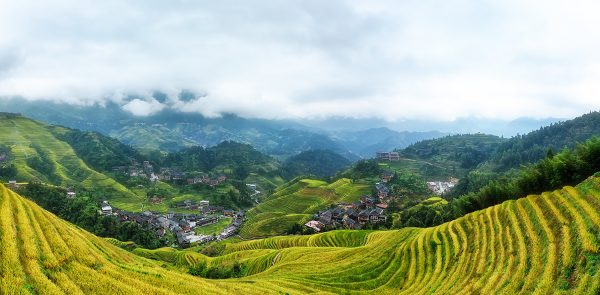
Compared to its northern cousin Ping’an, Longji Ancient Zhuang Village is relatively isolated from the outside world and has yet to be embraced as a tourist attraction. Its Chinese name, “Guzhuang Zhai” (古壮寨), literally means “Ancient Zhuang Village” in Chinese, so it is often referred to as “Longji Ancient Zhuang Village” to differentiate it from other Zhuang villages. The “Zhuang” in its name refers to the vast numbers of people from the Zhuang ethnic minority who call this village home. Guzhuang village boasts over 200 households and a population of approximately 1,000 Zhuang people, making it technically larger and more populous than Ping’an.
Guzhuang is located about 5 kilometres east of the town of Heping and 3 kilometres southwest of Ping’an. Like Ping’an, it provides access to the Longji Rice Terraces, although there are few designated scenic spots along Guzhuang’s rice terraces as the area has not yet been geared up for tourism. The rice terraces surrounding Guzhuang are far quieter, less crowded and seemingly more natural than those of Ping’an. This is because their primary purpose is rice cultivation and not tourism. Guzhuang is the perfect rural retreat for anyone who has become tired of the bustling crowds and tourist atmosphere of Ping’an.
Guzhuang village has been home to the Liao Family Tribe, Hou Family Tribe, Pingduan Tribe and Pingzhai Tribe for over 400 years. The whole of the village’s population is made up of members from the Liao family, the Hou Family, and the Pan family, which form the four tribes. These families belong to the Baiyi or “White Clothes” branch of the Zhuang ethnic minority and are characterised by their beautifully embroidered white shirts. In keeping with its ethnic aesthetic, Guzhuang village also has the largest collection of Zhuang Diaojiaolou in China. Diaojiaolou are traditional three-storey wooden houses that have been built on large stilts in order to protect the inhabitants from insects and snakes, although styles of Diaojiaolou vary between the different ethnic minorities. The Diaojiaolou in Guzhuang are some of the oldest in the country and some even date back over 100 years.
For the benefit of visitors, one of the oldest Diaojiaolou has been opened to the public so that tourists can get an idea of what it is like living in these traditional wooden houses. Walking through these old buildings endows any visitor with a wonderful feeling of peace and many tourists spend over half a day simply wandering through the village and getting lost in its antiquated beauty. There is also a museum in the village that is dedicated to the history, culture and customs of the Zhuang ethnic minority. The museum is full of fascinating artefacts, detailed historical accounts, and traditional dress of the Zhuang people.
Other architectural features of the village dating back to the Ming (1368-1644) and Qing (1644-1911) dynasties have been wonderfully well preserved and exhibit the extensive heritage of Guzhuang. These include the Longquan Pavilion, the Site of the Military Camp, the Clean and Honest Politics Stele (Lianzheng Stele) and several water mills. The stone bridges in the village are perhaps the most elaborate structures of all. There are 300 of these stone bridges scattered throughout the Longji Rice Terrace Scenic Area, 57 of which can be found in Guzhuang. These bridges have been delicately carved with images of lotuses, swords and the eight trigrams of Bagua[1] theory. The finest of these bridges is called “Three Fish Share One Head”, which is a Wind-Rain bridge located just in front of the village’s administrative office.
To get to the village, you first need to take an express bus from Guilin to Longsheng County Town or Heping Town, which takes about 2 hours. From Longsheng or Heping, you have to transfer onto another bus heading to Guzhuang village. Alternatively, you can hike from Ping’an village to Guzhuang, which only takes about an hour. Unfortunately there are currently no established hostels or hotels in Guzhuang village and the village itself is lacking in many modern amenities, so staying there overnight is not an option. However, nearby Ping’an village has over 80 hotels and hostels that are ready to welcome any weary traveller hiking back from Guzhuang.
[1] Bagua: The eight trigrams used in Taoist philosophy to represent the fundamental principles of reality. In their most simplified form, they symbolise the sky, the lakes, fire, thunder, wind, water, mountains and earth respectively.